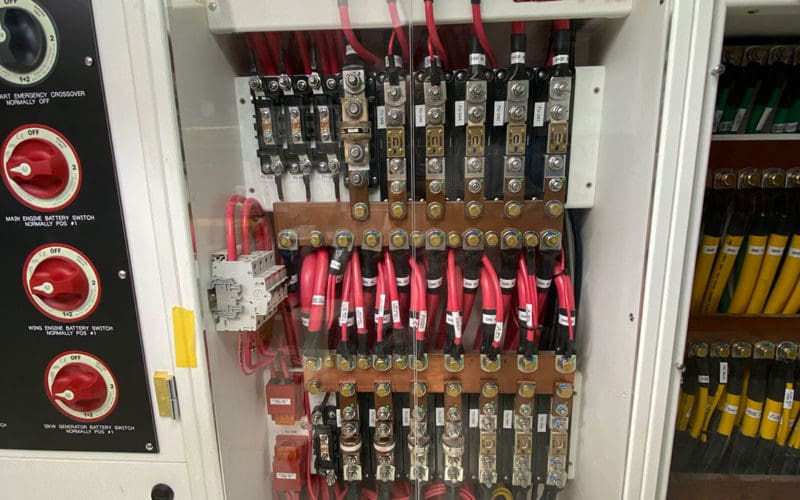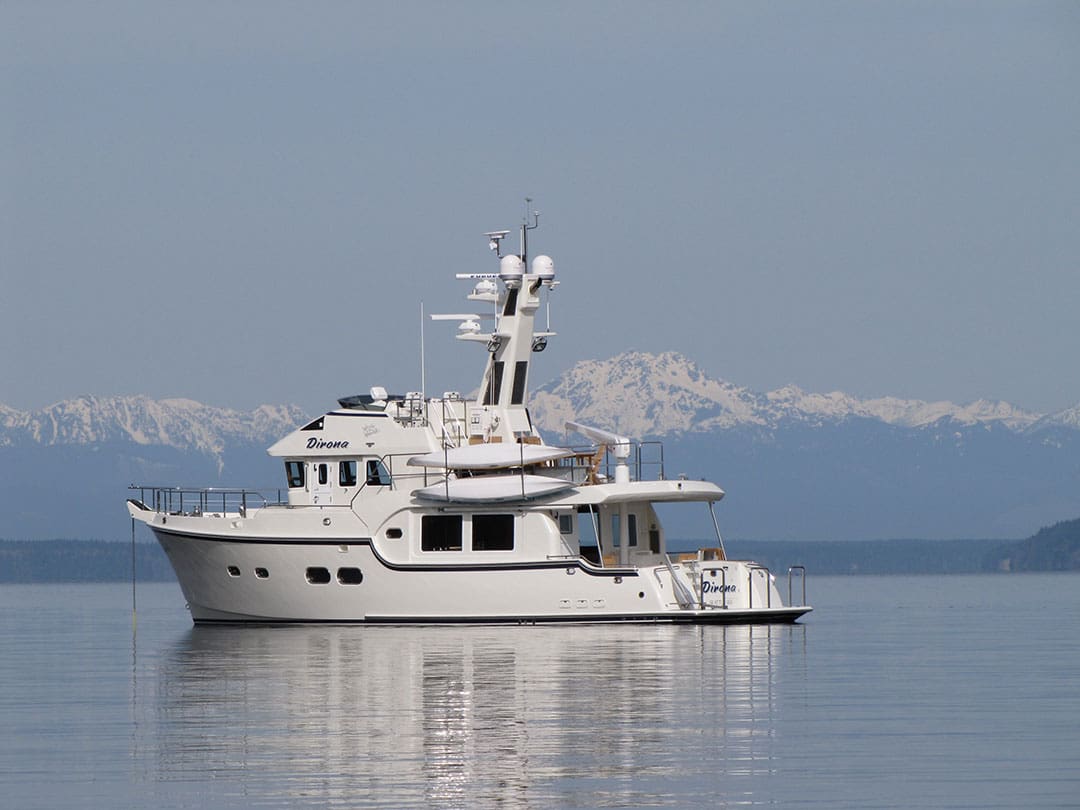
A defining feature of a luxury motor yacht is the efficiency and durability of its electrical systems. Whether at dockside, at anchor or offshore, crew and passengers need to know their vessel is capable of meeting their demands for safety and comfort around the clock.
Emblematic of highly evolved offshore vessels meeting these demands are those produced by Nordhavn, a builder of high-end luxury motor yachts in Dana Point, California. Nordhavn yachts feature fuel-efficient propulsion plants, along with aggressive electrical generating and power storage systems, designed to take voyagers across the world’s oceans in comfort and safety.

Electrically thinking
Before embarking on a discussion of electrical power and storage, a few words on Nordhavn’s design philosophy are in order. The underlying mindset of Nordhavn, from hull design to deck structure, nav station layout, main power plant, auxiliary power and battery storage, is one of overbuilding and ensuring back-up systems in case of system failure, which is, according to Nordhavn engineering manager Mike Telleria, virtually non-existent.
The shared parlance of Nordhavn’s design and engineering is an obsession with over-building and providing duplicate systems wherever possible to ensure the safety and comfort of crew and passengers.
Every inch of wiring and every electric and electronic device above and below decks is installed with meticulous care given to aesthetic appearance as well as to carefully routed wiring harnesses, switches, fuses, bus bars and ground cables. All batteries, electric wiring and component installations adhere to or surpass American Boat and Yacht Council (ABYC) and applicable international standards.
Amenities
The proud new owner of a Nordhavn N52, for example, can expect a generous list of amenities and creature comforts, which include a wide array of electric appliances and deck systems. In the galley you will find a large, front-opening refrigerator and freezer, an automatic dishwasher and a trash compactor. Nearby you will find a stacked washer and dryer combo, allowing crew and passengers to maintain a freshly cleaned wardrobe throughout an entire voyage.
Out on the foredeck of the N52 you will see a heavy-duty electric crane for lowering and retrieving your ship-to-shore motor launch. Just forward of the crane is a Maxwell 3500 vertical electric windlass, capable of pulling 3,500 pounds and holding in place up to 4,840 pounds. That is certainly more than enough power to retrieve any size of anchor and chain combination for this size of vessel, even in a stiff breeze. The unit draws 1,200 watts of DC current, which is backed by a generous source of generator and battery power.
Navigation equipment
The nav station in each Nordhavn yacht is custom designed and installed to meet the specific needs of the owner. As Robert Kinney of the Nordhavn electrical subcontractor Alcom Marine explains, coastal mariners usually opt for a minimal array of navigation and communication devices, including a VHF radio, radar and chartplotter.
An N52 outfitted for offshore cruising, on the other hand, carries radar, two depth sounders, two autopilots, magnetic and satellite compasses and other redundant systems. “The ocean crosser has complete duplication,” Kinney emphasizes. Offshore, opting to repair or switch out equipment is not practical, particularly in inclement conditions or in a crowded seaway within 100 miles of a harbor.
While underway, the total electrical draw for the entire nav station, along with various other electrical appliances and systems throughout the vessel, is 30 to 40 amps, which is easily backed by ample battery storage and power generating capacity. And of course, all electronic installations meet or surpass ABYC and applicable international standards to ensure safety and maximum functionality.
Vessel stabilization
While navigating offshore, any vessel, no matter how large, is subject to the vicissitudes of wave action hour after hour, day after day, through the entire voyage. On a sailboat, the sails help to attenuate this sideways action by constantly catching the air and stabilizing the vessel with opposing atmospheric resistance.
On large motor yachts like the N52, this sideways resistance is achieved via stabilizer fins placed on the hull underwater. Vessel stabilization is controlled by an electronic gyro that detects the rate and speed of roll in the hull, sending corrective action to the stabilizer fins while underway. Mechanical power is transmitted to the vertical-axis fins by an electronically activated hydraulic pump and a set of control valves.
For stabilizer fins to work properly, the vessel must be underway to allow Bernoulli’s Principle to take effect. Just as with a set of sails, the faster a fluid mass passes over a foil, the lower the pressure on one side and the greater the righting force at the side facing the oncoming water current. With a pair of stabilizer fins and a vast store of battery power to back them, passengers and crew can expect a consistently smooth ride in all conditions.
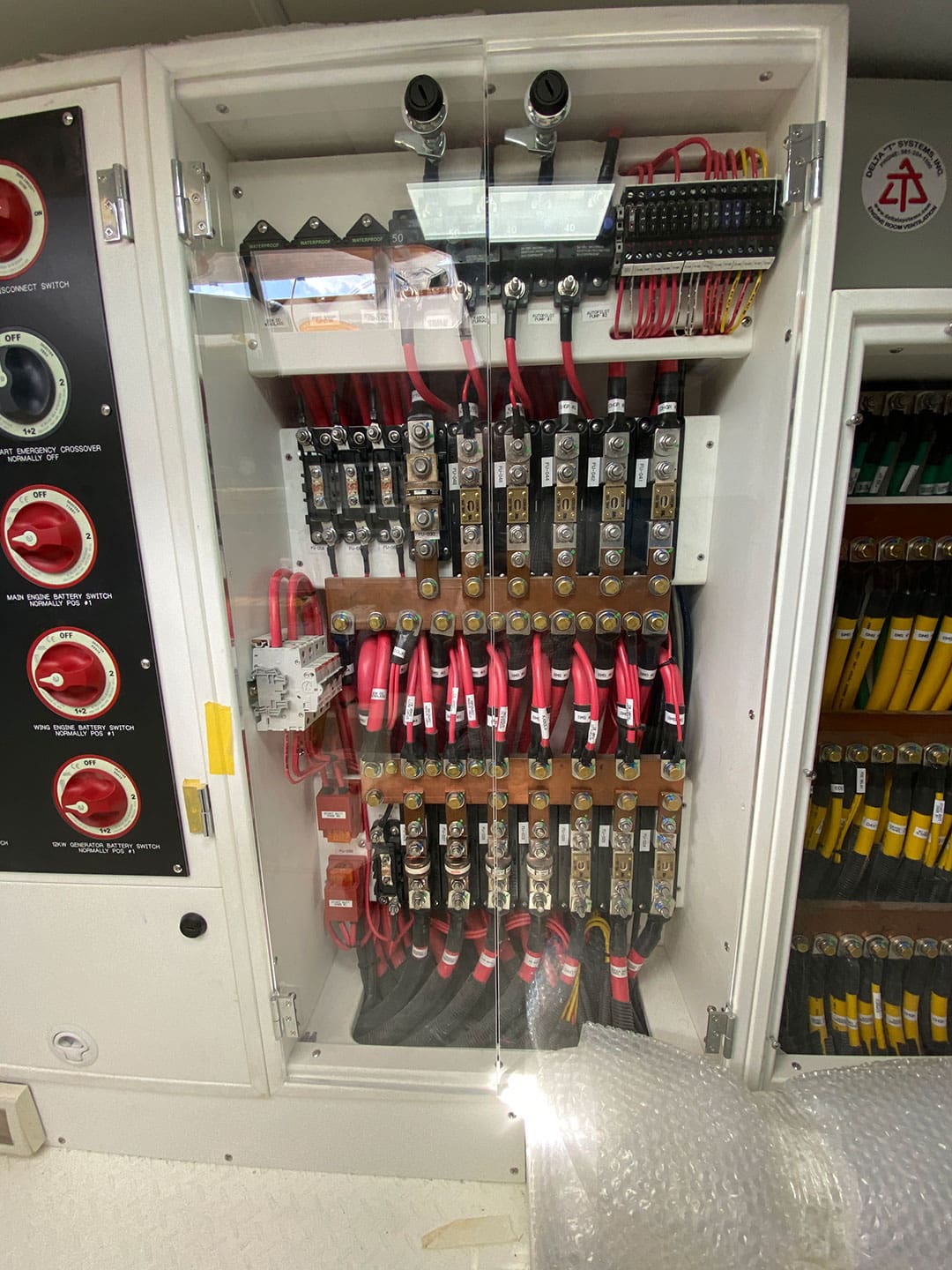
Electrical panel
All electrical systems aboard a Nordhavn vessel come together at a single panel, permitting easy, intuitive monitoring and management. The power for battery charging, navigation components, cabin and exterior lighting, refrigeration, air conditioning, watermaker controls and the balance of onboard electrical systems can be set from one location.
The electrical panel includes a parallel switch for emergency engine and house battery paralleling, plus an engine shutoff switch and panel. If it’s 02:00 during a mid-Atlantic storm, the skipper and crew can depend on one place to monitor and manage engine alternators, power inverters, generator output and battery usage.
Power storage
The key player in a Nordhavn yacht’s capacity for long-term sustainability at sea is its robust battery network. The starter bank in an N52 consists of two 4D batteries for the 24-volt starter motor on a 266 HP John Deere 6068AFM75 diesel engine. Aside from the starter and house banks, a Group 31 Lifeline battery, along with a dedicated 20-amp 12-volt charger and a separate control panel, is installed in the pilothouse to run electronics and small appliances.
Battery cables on all Nordhavn yachts are oversized to withstand the highest surges possible. The starter bank and optional bow thruster batteries are installed with size 0000 copper cables (nearly ½ inch thick) and size 00 cables for most other general installation leads. Thicker cables yield less electrical resistance and therefore a much lower chance of overheating.
In most of the vessels ordered, the house battery bank comprises six Lifeline GPL-8DL batteries, the construction and durability of which conform to Mil-Spec standards. Lifeline 8D batteries use absorbent glass mat (AGM) technology and boast a self-discharge rate of two percent per month, which meets or beats the lowest discharge rate in the industry. While most Nordhavn yachts still use lead acid AGM batteries, some of their latest custom vessels feature lithium-ion battery banks.
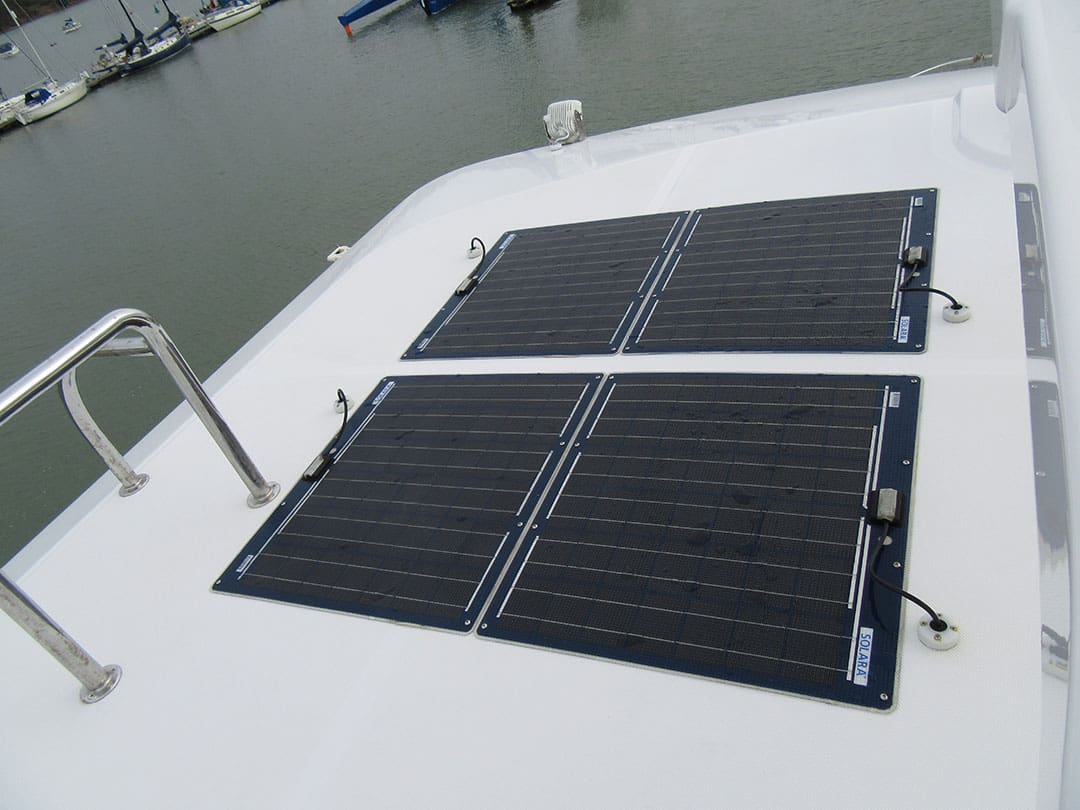
The house bank on the N52 can now be configured with six to eight Lithionics GT24V-315A-24 batteries, each rated 315 amp hours at 24 volts DC. That means 2,520 amp hours of 24-volt DC power at your fingertips in a 52-foot yacht! Another important feature: unlike the lithium-ion batteries commonly found in automobiles, the Lithionics Battery Management System (BMS) provides an extra layer of protection for the banks and the surrounding vessel.
The Lithionics battery management system monitors voltage, charge levels, temperature and other metrics to prevent accidental discharge. If for some reason a bank fails, the BMS automatically senses the drop in voltage and cuts the battery off from the remaining bank. This allows continuous power with a huge remaining stored electrical base for uninterrupted house current throughout the vessel.
Nordhavn’s flexibility in offering either AGM or lithium-ion batteries is grounded in a quest to satisfy the specific requirements of prospective owners, given their individual needs for battery power. Lithium-ion offers increased durability and an even lower discharge rate than that of AGM batteries. Although lithium-ion banks are far more expensive than lead-acid or AGM batteries, lithium-ion offers a much higher level of stored charge. Incredibly, two of the large Lithionics batteries installed by Nordhavn replace the available charge of eight 8D batteries.
What’s more, you can use up to 80 percent of fully charged lithium-ion battery, but only 50 percent of a fully charged AGM bank before threatening the battery’s longevity. The larger amount of usable power in a well-designed lithium-ion bank is clearly far greater than that available in AGM batteries.
When it comes to maintaining and monitoring battery charge levels, again, lithium-ion batteries outperform AGM. To begin, AGM batteries need to be fully charged on a regular basis to prevent sulfation and premature failure. Persistent low charge levels will require extended generator run times in order to provide that last 10 to 20 percent charge, which means more frequent fuel bunkering and more wear and tear on the engine alternator or house generator.
Lithium-ion batteries, on the other hand, can withstand lower charges with no ill effects. As a matter of fact, being left with only a partial charge can actually help a lithium-ion battery last longer, such is the unique chemistry of this type of energy storage technology. As amazing as it sounds, lithium-ion batteries have been known to last up to six times longer than AGM batteries.
Kinney explains that despite the prowess of lithium-ion, however, AGM is still the safer and more stable of the two technologies. A bank of six 8D AGM batteries offers far more power than a boat can reasonably expect to use on a daily basis while underway or at anchor. So unless an owner has a compelling need to use the more expensive lithium-ion option, there is a good case for installing AGM batteries.
Charging and monitoring systems
When you take off to the Marquesas in your Nordhavn yacht, you want to know you can watch videos, talk on the radio, take a hot shower and enjoy the AC at your whim with nary a worry about battery charge. Nordhavn’s standard selection of AGM batteries requires an aggressive charging and monitoring system capable of keeping up with the huge storage capacity.
The most important battery on any motor vessel is the starter bank, which needs to be fully charged and ready to use at a moment’s notice. The two 4D starter batteries are charged by a dedicated 40-amp, 24-volt alternator, and the house bank is charged by a 175-amp, 24-volt alternator. Although both alternators are powered by the engine, they, along with the two separate battery banks, are isolated from each other to prevent power loss in both banks.
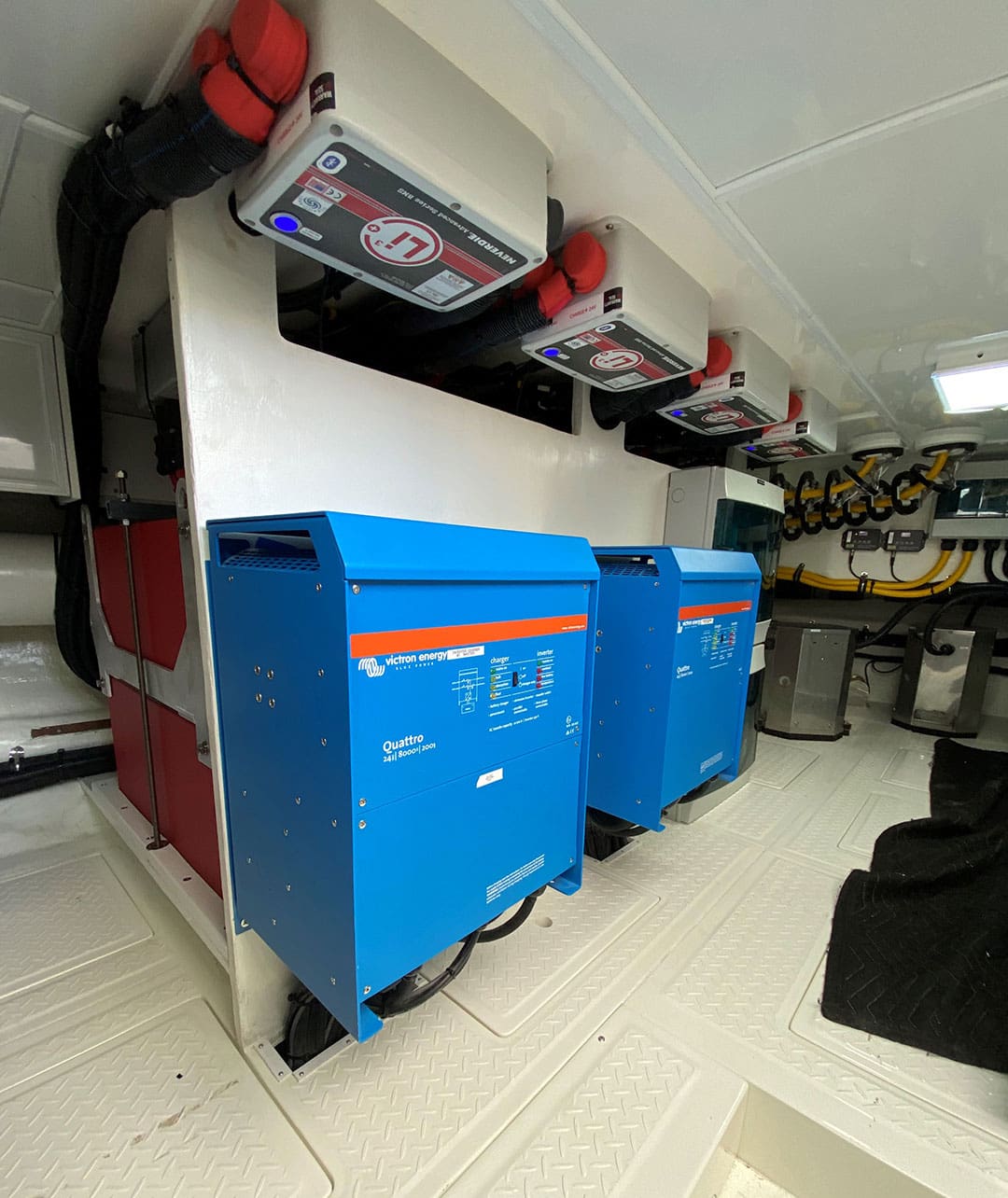
batteries.
Inverters
When you plug a coffee pot into the galley bulkhead on the N52, you are drawing power from a pair of Victron Quattro inverter/chargers, which provide up to 16 kilowatts of 120/240 volt AC power. The Victron inverters can be hooked up to shore power as needed to save diesel while you rest your heels after a long voyage.
The two Quattro units may be hooked up two independent AC sources, whether it is a combination of shore-side power and an alternator, or both alternators. The Quattro will automatically connect to whatever active source it is switched to. The main output has “no-break” functionality. In other words, in the event of a grid failure, or shore or generator power being disconnected, the Quattro takes over the supply to the connected loads. This occurs in less than 20 milliseconds so computers and other electronic equipment can continue to operate without disruption.
The Quattro also prevents overload from any given source, such as a generator or shore power connection. In the event of a surge, battery charging is automatically reduced in order to prevent overloading of batteries. This protects all appliances and dedicated shipboard systems from burning out from accidental current overload, thereby preventing overheating and the potential for fire.
Electrolytic control
Controlling electrolysis is a challenge on any vessel, regardless of hull material or the manner in which nav systems or amenities are installed. The most common conditions promoting electrolysis are stray AC and DC current and inadequately protected submerged metallic dvices. Nordhavn goes the extra mile when it comes to isolating electrical generating sources, inverters and devices from stray DC and AC current throughout each vessel the yacht builder produces.
To begin, all through-hulls are bonded together with no. 6 green wire and bonded to the 24-volt DC ground array. To this ground array all other submerged systems are also bonded: stuffing box, stern bearing housing, rudder shoe, rudder frame and rudder stuffing box. For added electrolytic protection, three sacrificial zinc plates, each measuring 2.5 inches by 5.75 inches, are tied into the system to disperse stray electrical charge into the water.
The N52 and other Nordhavn mid-range models are constructed of fiberglass and vinylester resin, so the hull structure itself is safe from corrosion and highly resistant to combustion except under the most extreme conditions.
Redundancy
Redundancy in electrical storage and wiring is Nordhavn’s way of ensuring, to the best of the company’s ability, the uninterrupted operation of all onboard systems, be they for navigation or for crew comfort and convenience. The large AGM battery storage system and electrical inverters, powered by a Northern Lights 240 volt, 60 Hz generator, allows batteries to support many of the vessel’s electrical components. This permits constant use of lights, air conditioning units, cooking appliances, watermakers, a washing machine and dryer, and so forth, around the clock while underway or at anchor.
Much of the overall safety of the N52 and other Nordhavn yachts lies in the company’s obsession with not only oversizing copper cables but also doubling them in critical, high-current installations, particularly from the main battery bank to the propulsion engine and from the auxiliary banks to the Victron Quattro inverters.
On yachts with lithium-ion house batteries, the huge amounts of power packed into 8D and 4D banks can generate a much larger amount of heat over a given length and size of wire than flooded or AGM batteries. This equates to more heat and stress on cables, connections, switches, fuses, circuit breakers and other electrical components.
For this reason, Nordhavn ensures oversized copper cables and wiring are standard in all installations. As a matter of fact, even in Nordhavn yachts still being built with AGM, the builder has begun upgrading all wiring installations to meet the demands of lithium-ion amperage and power requirements in anticipation of new owners opting to upgrade to the latest battery technology.
And just for good measure, even the cords connecting shore power to the Quattro inverters are doubled in order to reduce heat and electrical resistance in the copper cables, essentially eliminating any chance of overheating in the shore cables.
While small-boat skippers may view the probability of overheating in electrical wiring as a minor, easily managed concern, the captain of a large, ocean-going vessel such as the N52 or other model knows managing the electrical needs of the vessel plays a critical part of the boat’s safety at anchor, at dockside and underway.
Nordhavn is the quintessential example of a yacht builder committed to ensuring quality and safety in all of its vessels. From hull and deck design to amenities and robust electrical power and storage, Nordhavn’s design and engineering team goes to great lengths to ensure quality, safety, and ease of use. n
Contributing editor Bill Morris is a circumnavigator and the author of The Captain’s Guide to Alternative Energy Afloat (Seaworthy Publications, 2019)

